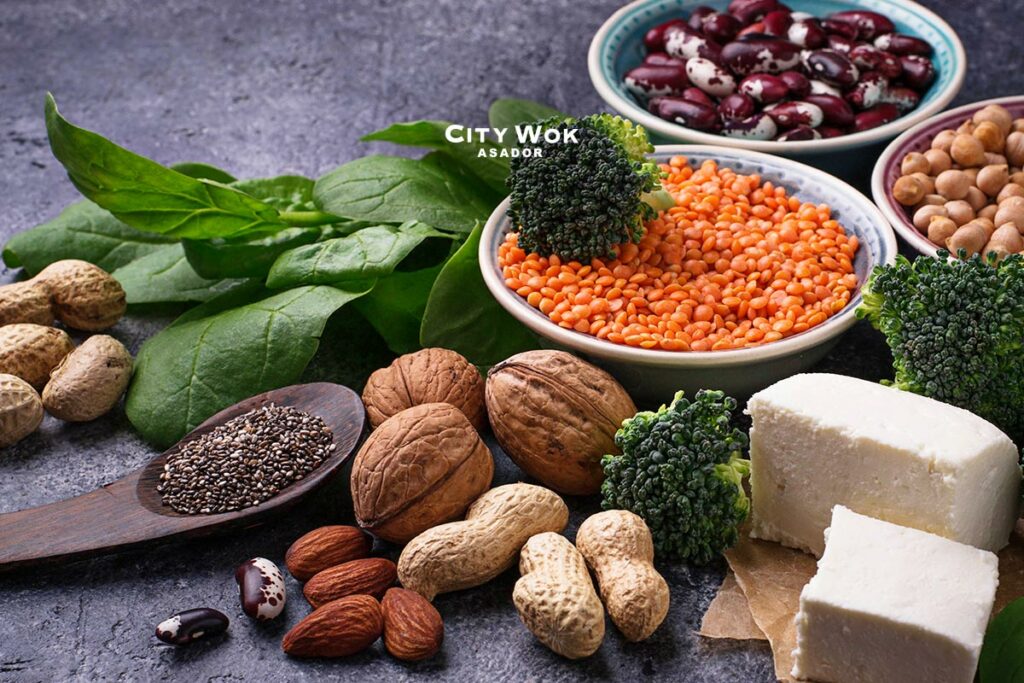Alimentos ricos en proteínas

Existe una gran variedad de alimentos ricos en proteínas y estos son necesarios en nuestro día a día para conseguir la energía necesaria. Es importante llevar a cabo una dieta sana y equilibrada donde se incluyan verduras, frutas, alimentos ricos en proteínas y carbohidratos principalmente.
Es por ello que desde Asador City Wok Alfafar os vamos a explicar los diferentes alimentos ricos en proteínas para incluir en nuestra dieta.
Alimentos ricos en proteínas
Cuando hablamos de proteínas, pensamos directamente en la carne. Y si es cierto que encontramos un elevado contenido de este macronutriente en la carne, también está presente en legumbres y otros alimentos. No solo vamos a hablar de los alimentos más conocidos sino también de algunos que no se sabía de su alto contenido en proteínas.
Pollo
Uno de los alimentos más comunes cuando hablamos de proteínas es el pollo. Este alimento es ideal para incluir en cualquier dieta ya que contiene un bajo contenido en grasas y aporta multitud de nutrientes beneficiosos para nuestro organismo. Se trata de uno de los alimentos que más proteína contiene y esto se debe a que representa casi el 30% de su composición. Por cada 100 gramos de pollo, encontramos aproximadamente 30 gramos de proteínas.
Su bajo contenido en grasa lo convierte en un alimento ideal para perder peso ya que solo contiene un 2% de grasa. Es importante recordar que también es una gran fuente de magnesio, vitamina B6, fósforo y zinc.
Champiñones
Los champiñones son una excelente guarnición no solo por su increíble sabor sino también por su gran aporte de nutrientes para el organismo. Se trata de uno de los alimentos ricos en proteínas que debemos incluir en nuestra dieta. Se trata de un alimento ideal con un aporte proteico elevado si quieres buscar una opción vegetal y dejar la carne de lado.
Los champiñones contienen aproximadamente 5 g de proteínas por cada 100g. Esto lo convierte en una gran opción para incluir como guarnición en tus platos. Un alimento con un gran sabor y con bajo aporte calórico para incluir en cualquier dieta.
Guisantes
Los guisantes son uno de los alimentos con gran aporte proteico menos conocido. Mucha gente asocia la verdura con la fibra pero pocos saben que se trata de un alimento ideal para ofrecerte energía necesaria durante todo el día. Si es cierto que debemos incluir los guisantes como guarnición ya que es necesario complementar la dieta con más nutrientes. Combinar este plato con arroz sería una combinación ideal debido a sus nutrientes y a su increíble sabor.
Quinoa
Considerado uno de los cereales más completos ya que contiene todos los aminoácidos esenciales para nuestro organismo y mucha fibra con efecto saciante. Esto nos evita comer mucho y picar entre horas. Una gran opción si queremos llevar una dieta alta en proteínas.
Cabe destacar que como no contiene grasas saturadas ni gluten, se trata de un alimento muy fácil de digerir. Se trata de uno de los mejores alimentos ricos en proteínas no solo de origen vegetal sino también en general. Ideal para incluir en cualquier dieta.
Soja
La soja es considerada como la carne vegetal ya que se trata de un alimento con alto valor nutricional. Sus grandes beneficios y su alto contenido en proteínas lo convierten en uno de los mejores alimentos ricos en proteínas.
Algo positivo de la soja es que lo podemos encontrar en diferentes variantes: salsas, leche, texturizada… Dos vasos de leche de soja contienen aproximadamente a 12 gramos de proteína. Un valor bastante alto al tratarse de un alimento de origen vegetal.
Podemos encontrar una gran variedad de alimentos ricos en proteínas de gran sabor para incluir en cualquier dieta. Muchos de ellos cuentan con un bajo porcentaje de grasas por lo que lo convierten en un alimento ideal.